By Lambert Strether of Corrente
“Everything Should Be Made as Simple as Possible, But Not Simpler” –Albert Einstein (attributed).
Let me dive right in by presenting with what I’m seeing right now:
Figure 1: The New York Times Front Page (New Version)
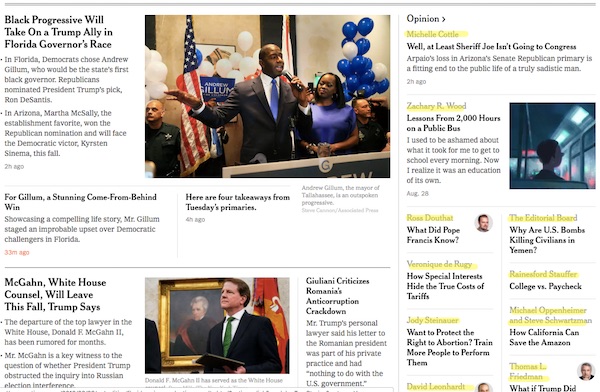
And here is a version of the Times front page from issues past:
Figure 2: The New York Times Front Page (Classic Version)
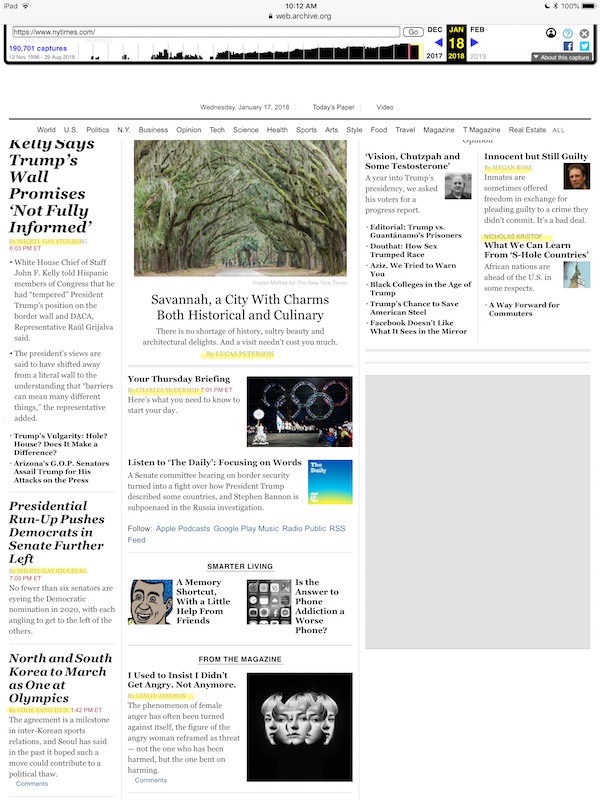
You’ll notice the main difference at once: Reporters no longer have bylines on the Times front page; there are other differences as well. (Let me just say right up front that it’s beyon absurd that Thomas “The Moustache of Understanding” Friedman deserves a byline, but Eric Lichtblau (say) does not.)
In this brief post, I’ll first look at reader reactions to the change; then I will look the absurdist parody of responsiveness to readers emitted by Editor Dean Baquet and Managing Editor, Joe Kahn; and finally I will speculate on the worrisome effects of this latest bout of crapification.
Reader reaction to the removal of bylines boils down to two points: First, readers use bylines as a form of quality assurance; and the Times, by retaining bylines for Opinion writers, is guilty of double standards. I thinks comment (from Baquet and Kahns’ article in the Times’ “Reader Center”) says it best:
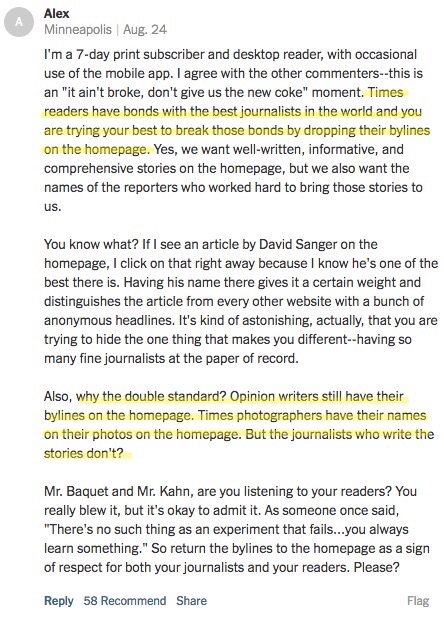
The strong form response to this reader complaint (not Baquet and Kahn’s, they being unresponsive, as we shall see) comes from Darrel Frost at the once-authoritative Columbia Journalism Review:
I don’t want people to sort their news via byline. Too many readers get their news exclusively from sources they are predisposed to agree with; untold articles have been written about the need to break out of our echo chambers. Saying that readers should choose their media diet based on individual reporters’ names seems antithetical to responsible news consumption.
While Frost’s remarks are buzzword-compliant (“echo chamber”), Frost doesn’t seem to be a serious newspaper reader. Any follower of the Iraq debacle — both the debacle on the ground, and the debacle at the Times — knows that the “Judy Miller” byline was important to quality assurance for readers; ditto for “James Risen” on intelligence, if it comes to that. Of course, as Times loyalists point out, readers can click through for the bylines, but why should readers have to do extra work to get information that the Times denied them?
The second reader complaint is that the Times redesign’s goal of unifying the desktop and mobile experiences is misplaced. From the “Reader Center” once more:
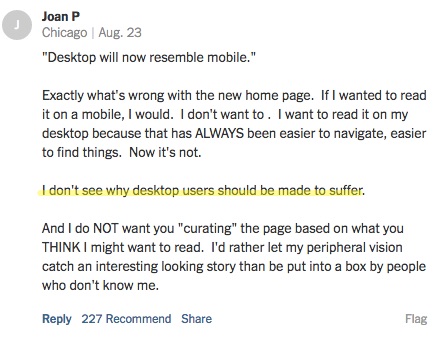
And:

Given that the desktop experience now includes a ginormous banner ad that sucks up all the space except for the headline of a single, unbylined story at the left, and a single, bylined opinion column at the right, I’d say these readers have a point.
Figure 3: The New York Times Front Page (with Banner)
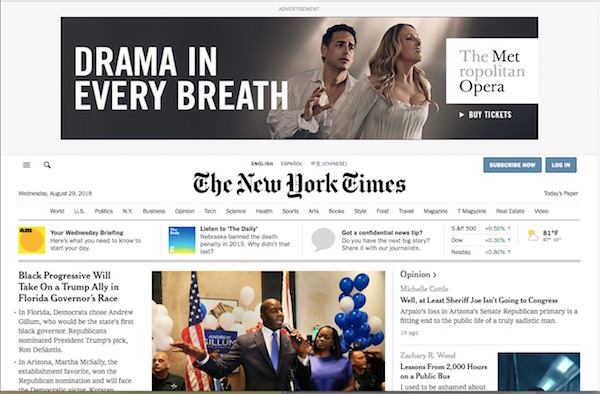
Why should the desktop and mobile experiences be unifed? Should books and comic books be unified?
Now let’s turn to Baquet and Kahn’s pathetic screed (tl;dr: “We’re gonna do it, and you’re gonna like it,” an attitude that will be familar to anybody who’s dealt with a top-tier 10%-er.) First, let me point out the result of the galaxy-brained Baquet having gutted the copy editing department. Let me just take a moment to include the date and time in the screen shot, because obviously:
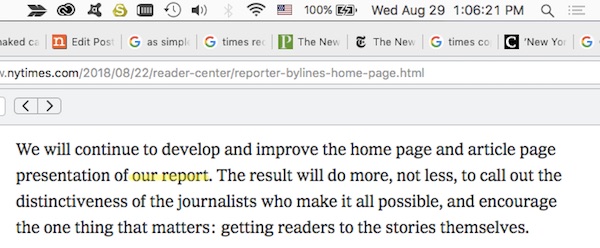
Surely Baquet (and Kahn) both meant to write, not “report,” but “reporting”?[1] And then there’s the sloppy writing. The headline reads:
Where Did the Bylines Go? Times Editors Respond to a Home Page Question
Nowhere in the body of the article is a question mentioned. I suppose I could infer that the question is in the headline — “Where Did the Bylines Go?” — but then the question should have been enclosed in quote marks, no? To make it appear that somebody asked it, and that Baquet (and Kahn) were actually being responsive, instead of just retailing their bullet points? Anyhow, there’s not much here; the whole piece is so shallow I don’t even need to get out my yellow waders. The lead’s first sentence:
There will always be bylines on New York Times stories.
(Even if stories are written by bots?) Not the point, as Baquet (and Kahn) must know; the reader concern is stories on the front page. More:
With the new design, bylines are now not displayed above summaries on the desktop home page. Desktop will now resemble mobile. Bylines have not been displayed above summaries on the mobile web or in our mobile apps, where more readers view our journalism than on desktop computers, for quite some time.
Shorter: “Desktop users will take it and like it.” More:
[P]lacing newspaper-style bylines above articles is not always the best way to engage readers or display the most important elements of our journalism.
I like “newspaper-style,” since Baquet (and Kahn) are saying that the Times isn’t really a newspaper anymore, but… something else we may, some day, have explained to us. Apparently this is the best way:
[W]e are moving toward placing their head shots and backgrounds on the article page. It is why, when appropriate, our journalists narrate reporting experiences in their stories, or talk about their findings in our audio and video productions.
Having to click through to a story and load a headshot to find out who wrote it is going to get old fast, especially if the reporter is the next Judy Miller… And I don’t really care about reading Roland Headley’s “reporting experiences.” I do care about his reporting, if any. Query: If Reporter A is a better reporter, but not so good on camera, and Reporter B is highly relatable on camera, but a lousy reporter, will the Times give Reporter A the front-page click-throughs, or reporter B? I’m guessing that Baquet (and Kahn) will go for reporter B.
Finally, let me raise three quick concerns about trends exemplified by the Times redesign.
Degradation of the Reporter. No matter how Bacquet (and Kahn) blather and squee, it’s clear that knocking reporter’s bylines off the front page is a slap at them, and decreases their institutional power. After all, if a byline on the front page weren’t an important signifier, the Times would hardly have celebrated the three interns who made it: “How Times Photo Interns Trusted Their Gut and Made the Front Page.” I remember when Dan Froomkin was a blogger at the Washington Post, and one of a tiny band of journalists who were critical of the Iraq War. WaPo originally made Froomkin easy to find (whether on the front page or not, I’m not sure). Then it buried him one level deep on menu of bloggers. Then it buried him two levels deep, and shortly thereafter Froomkin left. Well, that’s just what the Times editors — who will get bylines, as Opinion-havers — are doing to reporters on the front page: Burying them one level deep.
Devaluation of the Front Page. As before, Frost at the Columbia Journalism Review puts the argument in its strongest form:
This design change affects only the homepage—that is, a single page on a site with hundreds of thousands, and one that does not have any actual articles on it. (Bylines remain on all articles themselves, so anyone who actually reads a story sees who wrote it.) The homepage, merely a collection of links with occasional photos, serves the same essential function as Twitter—and where is the outrage when the Times links to news stories on Twitter without bylines?
(Again, cliché rich: “Where’s the outrage?”) Again, it’s hard to see how Frost can possibly be a serious or attentive newspaper reader. First, the front page, by its arrangement and placement of stories, signals to readers the institutional priority the Times places on a given piece of reporting, in relation to all other reporting at the same time (e.g., above the fold, and below the fold, a distinction that persists on the desktop, as the Times grotesque banner add shows.) Twitter, as a putatively chronological series of tweets, cannot by its nature send this signal. Second, the complaint that the front page doesn’t have any articles on it… Well, I’m just going to throw up my hands in despair. Google News is awful, but it’s not awful because it lacks articles. Third, the front page is the only place where readers can get an aggregation of contributors to the publication as a whole.
The Primacy of “Design”. The Times emphasis on “simplicity” reminds me of how Apple — another design-driven company — crapified the Mac laptop in its obsession of thin-ness. Sure, a thin laptop is great but not when it comes at the expense of a functioning keyboard. One can hardly avoid the sad conclusion — based on reader reactions above — that the redesign had little to do with readers. Boing Boing comments:
The thing is, “remove bylines and metadata” is always a top priority in the click-funnelling shitfeast of modern web design. So the outcome might have had little to do with the people who are being held responsible in today’s anguished and angry twitterings.
Indeed. Once that pesky variable of the byline is eliminated, Times editors can focus on writing clickbait y headlines, since those and the summaries are all that remain on the news-haver, right side of the page. “Iraq WMDs: You Won’t Believe What This One Reporter Did!”[2]. Lordy.
NOTES
[1] The good Doctor Freud would surely have a field day figuring that slip out, if he could ever get Baquet (and Kahn) on the couch. That, and the cake. There’s a famous quotation about cake, I’m sure I’ll be able to bring it to mind….
[2] I should have put a typo in the headline, but I just couldn’t bear to.


Get off my lawn, ya whippernsapper. The NYT is supposed to have an 8 column layout. Now the paper is so narrow you can’t even make a pressman’s hat out of it.
Narrow. That’s a perfect description of what the NYT has become.
I hate lawns. The smoothness of the clickbait-friendly mobile monoculture of the redesigned Times front page is more like a lawn than not.
Speaking of lawns, I get the physical NYT delivered five days a week, and all the bylines are still on the front page. I guess I’m not up to speed on all the devices folks are using now. On weekends I read the Times on my laptop, and yes, the homepage now omits author names, but I’ve never liked that layout anyway. Just click on the app Today’s Paper, and you see the same front page as the print edition.
People also hated The Rite of Spring at first.
But seriously, if airplanes don’t need human pilots,
why should
newspaper articlesmobile infotainments need human bylines?So its getting a USAToday redesign? I guess the NYT wants to be the number one newspaper no one reads at airports.
My immediate response to the changes to the Times Front Page, at a purely visceral level, is that they remove what remained of the unique personality the paper had. It’s as if the Gray Lady opted for a radical frontal lobotomy. The “New Version” Front Page looks like hundreds of other home pages on the web aptly described by your quip calling it the New York Times “USAToday redesign”. The Fourth Estate is consolidated in ownership, and content, and now trends toward consolidating its personality and appearance. Will the NY Times have to change its motto soon to keep up with the times?
The NYT redesign and the removal of reporter bylines is similar to a recent USA today column by the sportswriter Bob Nightengale which discusses the decreasing “value” of major league baseball managers.
https://www.usatoday.com/story/sports/mlb/columnist/bob-nightengale/2018/08/27/baseball-managers-salaries-joe-maddon-dave-roberts-aj-hinch/1102815002/
The article talks about long tenured and star managers who made large salaries are becoming a thing of the past.
Some snippets:
Welcome to life as a Major League Baseball manager, where the hours are long, the pressure enormous, and the job security lacking as front offices take more and more control.
There could be as many as 10 managerial vacancies after this season, from the West Coast to the Eastern seaboard
Notice the line “front offices take more and more control”.
The article is worth a read even if you are not a sports or baseball fan as it seems to fall in line with the trend of the diminishing value of anyone below the “higher ups”. I believe the NYT removal of bylines is similar in the implication that the “writer” does not matter. I imagine soon the NYT and other will make up new names and have algorithms write the content in similar vein to the baseball front office using analytics to generate “data” for that day’s game and the baseball manager just becomes a robot.
This seems to fall somewhat inline with the ideas in David Graeber’s book Bullshit Jobs and managerial feudalism. The increasing trend of algorithms/analytics is being taken too far and is a diminishment of work and craft. A good writer does not just spit out content and writing is a creative endeavor that takes years to master. It takes years for a good baseball manager to learn their craft : how to have a feel for the game, how to handle a pitching staff, and how to motivate players.
In a societal view I do not see this, gilded, authoritarian, and feudalistic, trend seeping into various industries as ending well for society and the working class.
The MBAs who managed to destroy the retail industries, even before the investment firms moved in to kill it, now are using their “expertise” to do the same to the rest.
I”m beginning to love the phrase word: “crapification”!
Thusly the NYT goes…….
The Times redesign doesn’t affect me very much because I always go immediately to “Today’s Newspaper”, then shoot down to the complete sections. (I was irked, however, when they removed the snippets from that page and the link coloration that reminded you which you had already clicked on. Did anyone protest these changes?)
The conspiracy sniffer in me perks up at the byline removal, nevertheless. If the Times were interested in downplaying the role of its core reporters, outsourcing more of its content or devolving more production to less autonomous, lower-paid staff, reducing their visibility would be the way to begin.
> they removed … the link coloration that reminded you which you had already clicked on
They did, didn’t they? (I just tested.) Anything to maximize clicks, I guess…
I haven’t even glanced at a New York Times (online or otherqwise) in well over a decade.
I haven’t read article links to the New York Times for a while now. The trouble of getting to the linked articles has long out-weighed the value I give their to content. I would never take the time to read enough of the paper to make a subscription worthwhile and after WMDs it grew evident week-by-week that the Gray Lady wasn’t lady anymore.
The Grey Lady wasn’t lady anymore:
I regard prostitution as the only honourable profession – that is those who are engaged in the carnal act. It can never be a lie.
However, those who lie for money or even worse – in support of an ideology, are a different matter entirely.
So leave out the ‘lady’ and perhaps apply “The Grey Liar” sobriquet instead*.
Pip-Pip!
*Did they ever apologise for the WMD thing?
As best as I can tell, the NYT sees its mission as distracting attention from what’s really happening and, once it’s got you, deliberately wasting your time.
Once every half year or so I get suckered back in: when they had a whole NYT Sunday Magazine devoted to “we can’t do anything about climate change” I had to read it, but having done so, once again I feel like Charlie Brown trying to kick Lucy’s foot ball.
The only “mission” I can image that accounts for the direction the Times has chosen is a desire to shape the opinions of the deliberately poorly educated products of the NeoLiberal re-working of public education to conform to Blob/Corporate ideology, presumably to maximize its revenues from Blob/Corporate sources.
A few times in recent months when I visited the Times online I received a “test” version of the home page, with an invitation to comment on it. I did take that invitation, twice, and stated that I found the proposed design awful–low information density, too much opinion, too much eye candy, a chaotic layout, not enough actual news and reporting. If anything, the design they have now rolled out is worse than the test versions I saw.
But what I most fervently want is a way to turn off tracking and their attempts to tailor content to me. When I click on stories, I am always wondering how that click is going to affect what is visible to me in the future. It absolutely affects which stories I click on. And I have always preferred, rather than click on the articles they put at the top of the page, to scroll down to the bottom of the page and click from the compact directory of articles. Now they have pumped that full of photos too, so it takes 3 screens whereas it could have fit in 1.
Is elimination of bylines an attempt to disguise stories written by AI bots as something written by a person? Would an AI bot even get a byline?
“The dispatch came with the clarity and verve for which Post reporters are known, with one key difference: It was generated by Heliograf, a bot that made its debut on the Post’s website last year and marked the most sophisticated use of artificial intelligence in journalism to date.”
https://www.wired.com/2017/02/robots-wrote-this-story/
adding:
https://www.techemergence.com/automated-journalism-applications/
Who needs city desk editors, copy editors, or writers when you can have cheap computer AI manufacturing the product?
Classic Information Age; information as product. It ties in perfectly with the commodification of human attention.
Soylent Green will be rolled out by ConAgra. Because they can! Once attention is commodified, the wetware that hosts the ‘attention’ will be similarly commodified. Indeed, it already is, by Big Medical.
So, seeing the propensity for ‘reimaging’ all things commercial, let me announce the new Behemoth in business: Obamagra! FEMA, what’s for dinner!
Indeed. Information as product – as opposed to information as a base of either knowledge or wisdom. Information as “information” as a discrete thing untethered to the larger scope of human understanding of the world and its manifold connections. See:
https://en.wikipedia.org/wiki/DIKW_pyramid
And “commodification of human attention”… where to start… There’s a difference, imo, between selling aspirin for a headache and trying to “reprogram” a viewer’s thinking to think that which they do not. I use the word “reprogram” advisedly. Anyway, great comment that my response is too short and feeble to do justice to. (“Remember the Maine” , or something.) Thanks.
Your comments always ‘do justice’ to the thing being commented on.
As for the divide between advertising and ‘news,’ I see it slowly narrowing to a concupiscent conjoination of codominions.
The ‘Enquirer’ pioneered the tabloid form of infotainment. That heady mix of news, advertising and outright lies is the eventual form for all the MSM outlets.
Hecht and MacArthur’s “The Front Page” springs immediately to mind.
And they know the bots have bias programmed in, they just have to keep selling the damn lie that it’s “objective.”
Why do I think removing the bylines was the main point and the rest of the “re-design” is a distraction from that purpose?
Bylines give writers (a type of artist) power.
Bingo! (or Jackpot or dindingdingding etc.) I think it’s telling the reporters that they are anonymous, interchangeable easily replaceable pieces of machinery and a means of making readers see the NYT as an article producing factory rather than a collection of people working as journalists.
Exactly.
What’s more, we see more and more cases of online news articles being materially edited hours after publication. If there is a reporter byline on the story, there might be some obligation to get the writer’s approval before twisting the meaning of what he or she wrote. No byline, no problem!
I’ll bet Stalin didn’t approve of bylines either.
Both reducing writer power and covering in advance (?) for bot-written articles strike me as likely motivations, but might there be another aim connected with the reader of a story rather than the creator? Why do opinion pieces retain their bylines? Because opinion pieces are about the writer, the writer’s ideology, the writer’s perspectives, etc. You wake up in the morning and absolutely must know what Friedman has to say. Removing the bylines from reported stories emphasizes that the NYT’s reporting is pure fact, unadulterated by the views/politics/financial incentives of any individual. It is pure veritas. It is beyond dismissing any NYT story as the product of bias because the entire contents are nothing but fact.
We are moving very fast toward the truth of the reporting of any event depends entirely upon the publisher. If an approved brand publishes a story, it must be true. To be skeptical makes one a conspiracy enthusiast. If an unapproved brand publishes a story, and it conflicts with a story about the same set of facts that appeared in an approved brand, then that questionably sourced story is fake news. What the underlying facts really are is of no importance.
I take this to mean that it’s getting a lot tougher to manufacture consent these days. Now part of that may have to do with changes in technology, but I’d argue that the main reason is that life is getting suckier for lots of people. Another problem is that the people in charge have been telling bigger and more frequent lies, and that’s increased skepticism.
This is all in vain. These lanyard-wearing Ten Percenters may know how to nudge and shame each other, but the rest of us wouldn’t give them any credibility if they claimed the sky was blue, bylines or no bylines.
Looks like teeters follow individual journalists
https://www.theatlantic.com/technology/archive/2018/08/trump-has-changed-how-teens-view-the-news/568783/?utm_source=facebook&utm_content=edit-promo&utm_term=2018-08-29T12%3A00%3A34&utm_medium=social&utm_campaign=the-atlantic
I always look at bylines. If there are two or more authors, I assume that one of them is a Political Kommissar enforcing Newspeak. I usually skip the article.
I now only read NYT articles to delve into the current psychosis of The Inner Party (1984). They (The Inner Party) wear their hearts on their sleeves. One of the sleeves being the NYT. CNN is another.
Read the NYT like the dissenters of Nazi Germany and Bolshevik Soviet Union read their Party Organs; Between the Lines.
Indeed. When I read a NYT article I find myself wondering what actually happened and how many years it will take until the public finds out about it.
With the metered news sites that only allow you a certain number of articles per month, there’s always an internal debate as to whether a given article is worth the click. I find myself skipping articles I expect to tell me things I already know… much more valuable are articles that will teach me something or surprise me with a new POV. NYT usually offers neither.
Thank you Lambert for putting words to the obnoxious attitude. “We’re gonna do it, and you’re gonna like it,” That sort bullying governs too much of our lives. I spend my life negotiating around unwanted ” improvements” on the internet and elsewhere. There is a maddening and growing form of totalitarianism and kitsch all over the internet—dictated to us in “take-it-or-leave-it” fashion. I despise those at Google, e.g., who persist in ever more daily cuteness. The whole lot of them deserve psychic torture for all eternity. There has been a revolution and we’ve lost.
Agreed on all this. One of the “improvements” that is driving me nuts: anything the
cursor touches, lights up / pops up / drops down/ opens up. This with javascript off.
Maybe that’s the plan, though…
I admit that I never read the NYT or WaPo. The articles are never informative (I can always find better articles elsewhere on the same topic) and, with limited time available, I want to read news, not propaganda.
That being said, the first thing that struck me when I saw the “new” front page was that it looked just like the “new” Google News–a site I immediately stopped reading when the change was made. My opinion, for what it’s worth, is that both the NYT and Google decided they no longer wanted to spend the time, and money, necessary, to make their websites readable on a variety of platforms.
I’ve been trying to imagine how someone might write a memoir describing the end of the world — that is the end of the world as we know it. I envision the end coming as a series of disasters triggering other disasters rather like Mr. Science tossing a ping pong ball into a room full of mouse traps loaded with ping pong balls. An individual must rely on the news and reports of others to know anything about what is happening beyond where that individual resides and the fairly small area of local travels. With the “news” available in these twilight times what sort of blindered chronicle might that memoir contain? I feel as if the continent of Africa could disappear below the waves joining the lost city of Atlantis and we might not hear about it for several days while we pondered Trump’s orange hair or some Kardashian ass.
Re: Machine over Man
I probably read this a dozen times after it came out in ’68 and now I feel like it was excellent prep for current layers of reality.
Stand on Zanzibar (SF Masterworks No15)
by John Brunner (Orion Millennium, £6.99, 650 pages, paperback; first published 1968; this edition published 26 August 1999.)
Most of Brunner’s fiction is prescient. “Shockwave Rider” and “The Sheep Look Up” being the two that come to mind first.
In general, since I was young, I find that the most dystopian science fiction works have come true whilst the optimistic screeds have not.
Two more books I haven’t read. Thanks for the suggestions! My goal was to write a little short story for fun about the times after the end of the world as we know it. I kept running into trouble doing that because I wasn’t sure what sort of problems and possibilities fit the most likely world of the future. I decided I needed to decide how the world would end so I could figure out what the future would have to work with. The longer term climate changes are the next problem to tackle. Most predictions seem to grow fuzzy past 2100. I am skeptical the future will be like a return to the 19th Century. like most of the “Into the Ruins” short stories.
Have a book suggestion. “The End of the Dream” by Philip Wylie written in 1972. It tells the story of how there is so much pollution present, that a series of unstoppable, violent, ecological disasters start in a cascade chain. Rivers polluted with chemicals that explode, flesh-eating lice encroaching on cities as the earth turns semi-uninhabitable. Good read from the 1970s.
Thanks! Added to the list.
Very good book by an underappreciated writer. Wylie died under ‘suspicious circumstances’ in his car on Key Biscayne. All this has been ‘sanitized.’ Another example of where the original reporting is cleaned up by person or persons unknown for shadowy motives.
I remember reading the original, more questioning article about his death at the time. Said article is now impossible to find on a quick search.
there’s a guy that wrote some novels about corporate executives advancing by duels, richard k. morgan. i enjoyed the concept.
Don’t executives advance by duels of intrigue and backstabbing combats. The use of actual combat weapons would spoil the fun. Your suggestion reminded me of an old Rod Serling television play I saw many years and which retains a strong impression on me even now:
[https://en.wikipedia.org/wiki/Patterns_(Kraft_Television_Theatre)]
Patterns was the first major breakthrough of Rod Serling when the live television drama received critical acclaim as the January 12, 1955 installment of the anthology series Kraft Television Theatre.
I suppose it fitting that Amazon has added this drama to its online video collection. I even found a recent, 2014, essay on it “A Dangerously Flawed View of Capitalism” in Counterpunch (possibly NC linked then?).
[https://www.counterpunch.org/2014/04/11/a-dangerously-flawed-view-of-capitalism/]
Thanks for the book suggestion and the link. I wasn’t aware of either.
All this makes the NYT even more irrelevant than being the capitalist Pravda did. I don’t trust anything they say since Judith Miller. Even if some things are true, the best way to get propaganda accepted is sprinkle truth amidst the lies
I’ve sensed for some time now that the design of even intellectual online magazines has been (purposely) making authors’ names, and article date, hard to locate.
Thanks so much about those missing dates (HUH? UNDATED), in particular.
I initially thought it had to do with my outdated browser when I couldn’t find a date on so many Online™ articles .
I almost wish I had never downloaded a brand new browser (and am very glad I did not delete my old one).
What sort of insanity is it when there is no date — let alone time of day, in certain circumstances — noted, when something is written about?
I am amazed by how many publications don’t offer dates. Sometimes I have to check the source code to find out!
Gotta keep stale inventory fresh for clicks, I guess
yep. As I recollect, ABC news articles I’ve retrieved — when attempting to search back into a history of an issue — are the first offender to come to mind there. Then there’s also that asinine, this was posted 457 weeks ago bit, from quora.com, etcetera.
And when I think about it, the same no date negligence has been happening for well over a decade in the billing and other vital ‘hardcopy’ correspondence arena — for those who still insist on writing checks and refusing online payments and accounts, for perfectly valid reasons. Then there’s also the no postmark date on the envelope when the important and timely correspondence arrived after the date you were required to respond. That, even though the USPS (United States Post Service, which initials Bill Gate’s software doesn’t recognize, though it does recognize FedEx, and UPS as proper spellings) used to actually contact companies if they even suspected they were finagling that leased Pitney Bowes, office stamp machine which used to always show a postmark date (I think it may have been a legal requirement at that time for many companies to show a postmark date on envelopes).
But never mind, apparently we just don’t want to accede to our brilliant, technocratic (rarely, if ever, in the average person’s favor) Meritocracy™.
While I was visiting my mother, who subscribes to the paper NYT, I didn’t spend much time reading it.
Why not? The layout was too dense! The type was too small, there wasn’t enough space between the lines, and the columns were too narrow.
OTOH, I spent a lot of time with the printed Philadelphia Inquirer and the local paper. Both were much more readable.
The New York Times. Determined to be the ‘Red Delicious’ apple of the newspaper world.
>Surely Baquet (and Kahn) both meant to write, not “report,” but “reporting”?
No, the NYT refers to itself internally as “our report.”
I think the obvious logic for the homepage crapification is that it is now possible to have it laid out by the same team that does the dire NYT app – ie, they get to fire another pod of quasi-journalists whose jobs appear equivalent to buggy-whip makers in the era of the Model T.
If most people gets their news feed channeled by Facebook, Google or, as in this case, through a crapified, filled with ads, news homepage… doesn’t this disqualify the economic theories based on equal access to information and rational expectations?
McClatchy newspapers are using the same redesign. Must be a thing. Design for smartphone readers. (those bylines take up valuable pixels on a tiny screen) bleh…
Look folks, this is what you get when data (or, if you will, documents) gets mistaken for apps (programs).
A problem that has been with us sice the beggining of the web; these problems were never part of the normal (i.e. non-online) computing; data files and feeds would be viewed and manipulated by programs that the user would choose and install, and the choice was informed both by useability and aestethics of software.
As a consequence I can still use Windows 7 and Office 2007, as I find the latest offerings by MS to be horrible beyond any measure (also objectively less usefull, but that could have been fixed by various add-ons), some people still use WinXP and some even cling to “good” old Win98; all that is possible by the miracle of user held control, that off-line platforms offer.
Don’t like the “new-and-shiny” (aka “feces”)? well don’t use it then. Can’t quite do that when they hold by the b*lls, since the app (the web page) downloads from their server on-demand, now, can you?
——————————————————————–
It’s interesting how those who kept screaming about Microsoft (“illegal monopoly” and other complaints), failed to notice or vocalise about a much larger and meaner techno-totalitarianism that was wrought upon us by google and other “content providers.”
I just discovered a much better way to see what the NYT has to offer (at least on a real screen, I haven’t tried this on a phone). Skip the home page and go straight to http://www.nytimes.com/section/todayspaper . There, you only need to scroll down a couple of screens to get past the eye candy, to the table of contents: yes, an actual list of headlines and bylines, in a consistent format, without photos.
How disappointing that the NYT now looks just like any of the many other digital news media. So much for a unique, pleasant, easy and efficient to read news media. MY DESKTOP IS NOT MY MOBILE PHONE!
I’ve been reading the digital version on my desktop for several years and found it quite easy to view and navigate. The redesign is a definite misstep. It’s poorly designed for the desktop. Too much white space that makes the eye wander all over the page rather than down a column. Best to have the NYT sent as a email. Much more straightforward in readability.